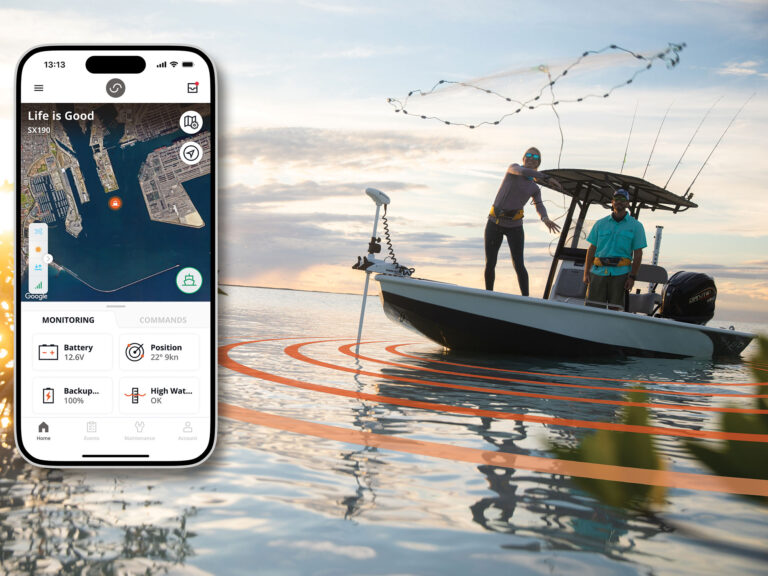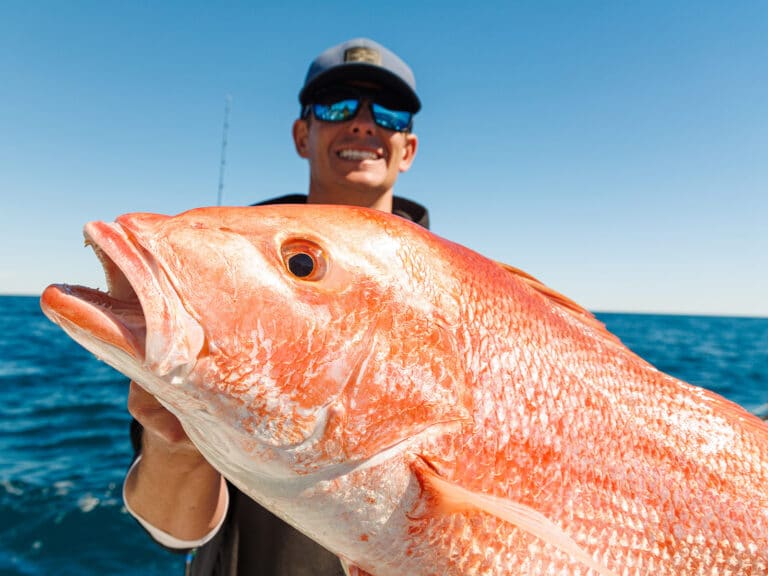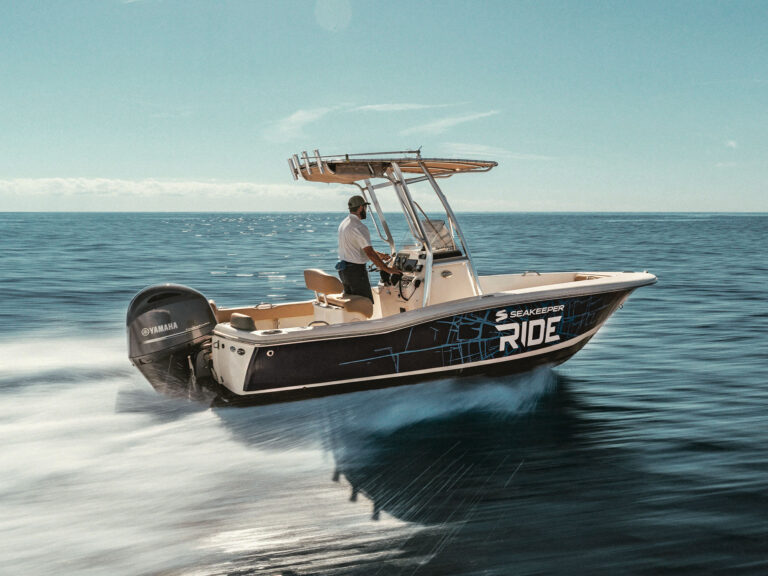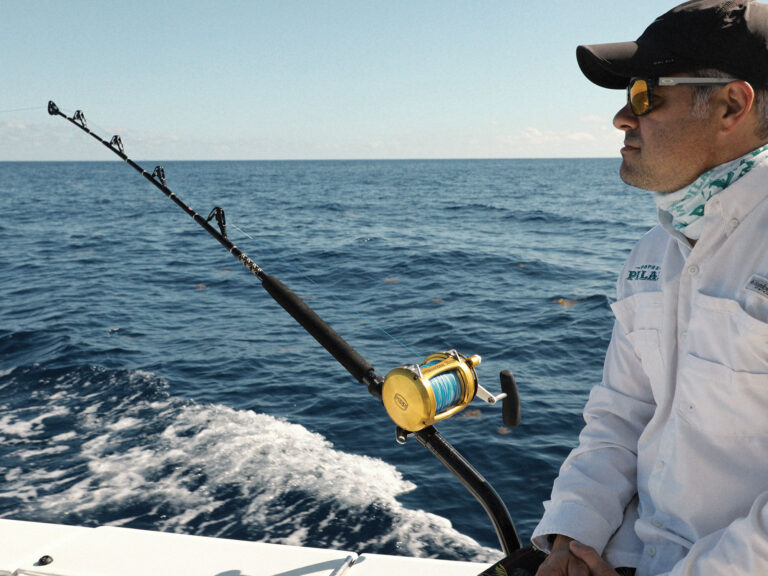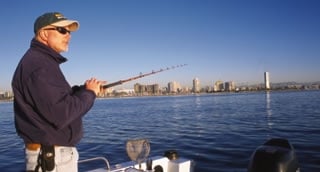
| Jim Hendricks drifts for halibut in the shadow of the Long Beach skyline. The crowded harbor regularly produces excellent catches of flatfish, along with calico bass, croaker, white seabass and more. |
California’s Long Beach Harbor is the kind of place most anglers can’t wait to leave in their wake. It’s industrial, crowded and noisy, and if that’s not enough, its waters are patrolled by paramilitary vessels bristling with serious weaponry. If it wasn’t such a great jumping-off spot for anglers bound for other, “more desirable” grounds, it would probably rank right up there with Baghdad on the list of places to avoid.
Hundreds of private and charter boats depart each day from docks and launch ramps throughout this giant harbor, headed for the offshore banks, Catalina and San Clemente Islands, or popular nearshore spots such as the Horseshoe Kelp or Huntington Flats. For those who know where to look, however, awesome fishing can be had just few minutes from the dock. Best of all, it can be enjoyed in nearly any weather, in almost any craft from a kayak to a 40-foot sportfisher.
Inshore Smorgasbord
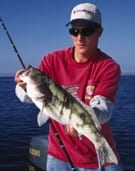
Josh Hendricks displays proof that decent sand bass action can be enjoyed inside the busy harbor.|
“Almost any fish you can catch on the outside, you can catch on the inside,” says Mike Gardner, a well-known light-tackle guide who specializes in fishing the Long Beach area. He confirms that the harbor is an excellent year-round hot spot that is often ignored, even though it’s right under the nose of thousands of anglers. Among the species Gardner and his customers regularly catch are sand bass, calico bass, spotted bay bass, halibut, spotfin croaker and white seabass, to name a few. “Just about everything comes into the harbor at one time or another, including thresher sharks and even great white sharks,” he adds.
Long Beach Harbor is unlike any fishing spot in the world. A giant breakwater system encloses Long Beach and adjacent Los Angeles Harbor. Combined, the two harbors make up the third busiest shipping port in the world behind Hong Kong and Singapore. Among Long Beach’s famous landmarks (or watermarks, if you will) are the Queen Mary (the ocean liner turned tourist attraction) and the massive dome built to house the Spruce Goose (its popularity with visitors lasted only slightly longer than the giant plane’s only ill-fated flight).
While fishing here you’ll see cranes passing gracefully overhead, but they won’t be the feathered kind. The skyline is filled with the mechanical monstrosities, busily unloading freighters laden with automobiles, toys, electronics and shoes from Asia. The shorefront reverberates with the noise of industry, and scores of oil tankers often crowd the harbor.
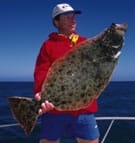
Big halibut like this are a favorite target of Long Beach regulars, who routinely find flatties along the harbor’s breakwalls, islands and other manmade structure.|
A Beautiful Thing
Still, beauty is in the eye of the beholder, and catching fish is always a beautiful thing. “The quantity of fish you can catch in the harbor is just amazing,” declares Gardner, who considers 50 to 70 fish among four anglers a “slow” day. “It’s common for a group to catch 200 fish a day when the bite is really on.” Gardner adds that he catches a lot of big fish too. In fact, he counts a 9 1/2 pound sand bass, a 42-pound halibut and a 13-pound calico bass among his personal “harbor bests.”
Gardner credits his success to the special light-tackle techniques he developed just for Long Beach and other urban fishing areas. “The lighter the line, the more you’re going to get bit – I can’t put it any plainer than that,” he says. Gardner favors six-pound-test, clear monofilament line and fishes exclusively with small artificial lures, primarily curly-tailed grubs or three- to four-inch swimbaits fished on 3/8-ounce leadheads. His go-to pattern is chartreuse and gold.
“The second key is to fish where the fish are,” Gardner continues. This means focusing on structure – piers, pilings, docks, wrecks, channels, weed beds – anything that can attract fish.” To help locate prime underwater features such as wrecks and the dredged shipping channels, Gardner relies heavily on his combination GPS/chart plotter/depthsounder. Over the years, he has built up an electronic record of proven spots that produce under various conditions.

The harbor is home to such attractions as the Queen Mary (right) and the Spruce Goose Dome.|
Hit the Islands
For those starting from scratch, Gardner recommends working the harbor’s “oil islands” – manmade islands that were created for the purpose of slant-drilling for oil under the city of Long Beach. These four islands – Island Chaffee, Island Freeman, Island White and Island Grissom – are easy to find and provide a wealth of fish-holding structure. If you search the bottom with your depthsounder, he says, you’ll find rock piles well away from the islands, especially off the southeast shore of Island Chaffee. Another hard-to-miss piece of structure is the breakwater, which has developed its own following of private-boat anglers who fish the wall – particularly at night – for tackle-busting calico bass.
Tidal movement is another important consideration. “Moving water means feeding fish,” states Gardner. “I try to fish on days with 3 1/2 to four feet of tidal movement. Fishing usually peaks during an incoming tide, but an outgoing is better than no movement at all.”
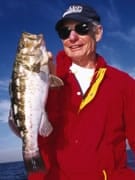
Calico bass hold directly on top of rocky structure in the harbor, while halibut lurk around the perimeter.|
Gardner has found that the species he catches depends on what part of the structure he’s fishing. “For example, when you’re working a rock pile, it’s not unusual to find calico bass on top of the structure, sand bass and spotted bass around the edges, and halibut farther out, on the outskirts.” He works his lures slowly over the bottom, and advises his customers to be ready for the subtlest of bites. Taking a page from his popular book, Fish Don’t Have Hands, Gardner says that even the slightest “tick” or change in line tension can indicate a pick-up, prompting an immediate hook-set.
While nobody can argue the effectiveness of Gardner’s light-tackle techniques, traditional methods can also work in Long Beach Harbor. Many harbor anglers score by drift-fishing live anchovies, sardines, smelt or squid. Others have perfected the technique of targeting huge halibut by “bounce-balling” baits or artificials along the bottom, a favorite method of commercial halibut fishermen.
Small-Boat Paradise
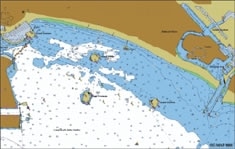
Long Beach experts often fish the harbor’s four manmade oil islands, shown here on an electronic chart from C-MAP.|
Josh Hendricks, son of frequent Salt Water Sportsman contributor Jim Hendricks, spends a lot of time working Long Beach Harbor from his small boat. Like Gardner, Hendricks has pulled an incredible variety of fish from the harbor’s waters, everything from croaker, halibut and white seabass to thresher sharks and even a 20-pound striped bass!
Hendricks agrees that current is key to success, and his preferred technique is to drift along the outer edges of docks and pilings, bouncing a live bait or ghost shrimp along the bottom. He usually rigs with eight- to ten-pound line and a 1/4-ounce egg sinker to get the bait down. Hendricks looks for current running parallel to structure, such as a row of docks or a seawall, so he can to cover ground and keep his bait in the strike zone as long as possible. He also fishes the oil islands, particularly their downcurrent sides.
“If there’s no current, I’ll anchor along a wall or other structure and chum with cut sardines or anchovies,” Hendricks says. “Sometimes this can really get the bite going.”
|||| |—|—|—| |### Guided Trips| Anglers who’ve never fished Long Beach Harbor before, or want to learn light-tackle, private-boat techniques for any of Southern California’s inner bays, would do well to book with Mike Gardner, (714) 671-0447, www.mikegardnersfishing.com. He can take up to four anglers on his custom-designed, 24-foot center console.
Receivers Are Producers
Not surprisingly, the harbor’s live-bait receivers also are excellent targets. With their net pens bursting with fish and squid – not to mention occasional escapes slipping through holes in the mesh – the receivers are magnets for marine predators. When conditions permit, position your boat to drift past the receivers, paying particular attention to the downcurrent sides.
“I love fishing the harbor. It’s reliable, it’s close to home, and, as long as it hasn’t rained, it can produce great fishing all year long,” Hendricks remarks. So, if the weather or a lack of time is keeping you from heading offshore – or if you just want a change of pace – try a day in Long Beach Harbor. You might find beauty where you least expect it, amid the hustle and bustle of one of the world’s busiest ports.
|||| |—|—|—| |### Security Issues| With 65.5 million metric tons of cargo moving through Long Beach Harbor in 2002 alone, this area has always been considered a prime target for potential terrorist activity. Efforts to secure Long Beach and Los Angeles Harbors have created new rules that anglers must be aware of. For example, private-boaters are generally restricted from fishing the inner harbor or the many inner basins and freight piers – once popular angling spots. Boats are also prohibited from coming within 100 yards of any cruise ship, oil tanker or moored commercial vessel, or within 500 yards of any military vessel. If you do start casting your line in a restricted area, don’t be surprised if you’re greeted by a Long Beach Port Police patrol boat or a Coast Guard RIB complete with bow-mounted, 50-caliber machine gun. They’re doing a tough – and very important – job, so smile, thank them for their hard work and quickly find somewhere else to fish. – Ron Ballanti





